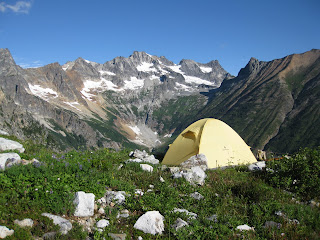With six days off together in late August, Dave and I had planned a big trip, way back into the North Cascades, one of those climbs where only the first few hours are spent on a trail. In two days, climb the alpine rock route for two days, find our way out by a different cross-country route for two days. Mt Terror - mmm. But having learned our lessons about impending inclement weather and trying to cram too much into time off, we decided to change objectives and do a slightly shorter climb of equal quality - the NE buttress of Mt Goode. (Goode instead of Terror - see, we're learning...)

We drove to the trailhead on Rainy Pass the night before, looking up toward the Pickets and feeling good about not wandering around in the rain. Starting out at the PCT south trailhead, our path soon veered off that trail and up a side valley, away from the likelihood of encountering other people. Sixteen miles in, camped at the end of the trail by a beautiful river, all to ourselves. Next morning, bushwhacked and scrambled up 2000 feet to another amazing campsite, settled in, and then walked up to the start of the climb to make sure the glacier would let us pass. A few cracks to step over, but getting onto the rock was assured. Next morning we were up before light, moving early so as to start the rock climbing at first light and maximize our daylight travel time.

The NE buttress of Mt Goode is a classic but not often done route in the Cascades. It's a good ways in, and the route itself, while not necessarily difficult, is long and committing. It is 2800' of rock climbing, and retreating partway up would involve leaving a lot of gear behind. The way we went, when you reach the top you have to go down the back side of the mountain and walk all the way around, to the top of another small glacier which you descend to get back to camp. But it's in a fantastic setting, way up an unpopulated wilderness valley, long and beautiful and remote. The only people we saw were two hiking in as we were hiking out the last day.

We moved pretty well on the third- to fifth-class terrain, roped the entire time but with more or less protection as the steepness of the rock dictated. Close to the top we came across a bivy site perched on the edge of the ridge with melting snow just retreating from the edge - a perfect place to melt water and replenish for the second half of the day: getting down. On a long, hot day, it's more efficient to carry two pounds of Jetboil stove and fuel than to carry countless liters of water at two pounds per liter. We filled up all our water bottles and scoped out the decent notch before continuing on to the summit.

The Cascades continue to be one of the most beautiful places I have ever been. From the top we could see snowy volcanoes, lakes and valleys, and a sea of peaks in every direction. It is in a different quarter than most of the climbing I have done, so mountains are rearranged and showing a different side from this perch. It is staggering to think of how many things there are around us to climb, but the sun continues to move through the sky and we must begin our descent. Rappel, scramble, rappel, walk down a gully, cross some snow, hike up, cross more snow, ascend to a small pass, rappel, downclimb 50 degree snow to the glacier... turn on headlamps. Weave through crevasses, dodge more crevasses, watch the full moon rise, skirt a rock band, arrive at the slopes just above camp. Camp.
Next morning, we took a little time to appreciate the beauty of this place that cannot be described, only taken in. Then packed up, made our way back down to the valley trail, and hiked the 16 miles back to the trailhead. The beauty of a sleep-in-able vehicle is that we didn't have to go anywhere, just to sleep and listen to the returning rain on the roof of the truck.